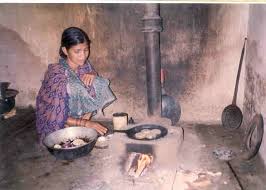HWN Jobs
- TROOP PHARMACY AND STORES JOBS
- TOTAL HEALTH TRUST LIMITED (2016) JOBS
- INTERNATIONAL MEDICAL CORPS (IMC 2016) JOBS
- PILLS AND TABS LTD JOBS
- HOUSE OFFICERS JOBS AT UNIVERSITY OF ILORIN TEACHING HOSPITAL
HWN Blogs
- Classical heart healthy foods on HWN BLOGS
- Classical Warning Signs When The Human Liver Begins To Fail on HWN BLOGS
- Myths About Hygiene, Soaps, Germs, Sweat and Smell on HWN BLOGS
- Hernia does not heal on its own on HWN BLOGS
- Classical Essential Oils That Improves Focus Cum Memory on HWN BLOGS
news - Cooking with biomass fuels more likely to cause cataracts on HWN RESEARCH back to all News
Cooking with biomass fuels more likely to cause cataracts on HWN RESEARCH

Women in India who cook using fuels such as wood, crop residues and dried dung instead of cleaner fuels are more likely to have visually impairing nuclear cataracts¹, according to a new study published in the journal Environmental Health Perspectives.
The study, the largest of its kind, was conducted by the London School of Hygiene & Tropical Medicine, Aravind Eye Hospital and the All India Institute for Medical Sciences. It found that Indian women who cook with biomass fuels were nearly 50% ² more likely to have cataracts than those who use clean fuels such as gas. The associations were not observed for men, probably because cooking was almost exclusively done by women.
The population-based study, funded by the Wellcome Trust, involved nearly 6,000 people aged 60 and over from randomly chosen rural villages and small towns in north and south India. Participants were interviewed at home on their use of cooking fuel over their adult life, and on a range of socioeconomic and lifestyle factors. A week after they were interviewed the participants attended hospital for an extensive eye examination including lens photography—over 40% were found to have visually impairing nuclear cataracts.
After taking into account other risk factors including indicators of poor nutrition, sun exposure, smoking and chewing tobacco, the researchers found that women who cooked with biomass fuels were 46% more likely to have nuclear cataracts compared to those who used gas. Furthermore, the researchers found that cataracts were more likely with increasing length of time the women had used biomass fuels, from 50% more likely for 20 years use rising to 90% after 30 years.
Biomass cooking fuels are particularly common in India, especially in poorer communities, as they are generally cheap and easily accessible. Recent estimates suggest that 83% of rural households and 19% of urban households in India use them. However, they are typically burnt in open stoves exposing households to high levels of health damaging pollutants including small respirable particulates. It is thought these may impair the eye's defence system, accelerating the clouding of the lens leading to cataract.
Professor Astrid Fletcher from the London School of Hygiene & Tropical Medicine who co-ordinated the study said: "India has one of the highest levels of cataract in the world. In common with many other countries, the proportion of vision loss, including blindness caused by cataracts, is higher in women than in men. We also know that cataract starts at an earlier age and progresses faster in India than in other populations but the reasons behind this are less clear.
Our study provides the strongest evidence yet of an association with adult lifetime exposure to biomass fuels and cataracts. This was only found in women, probably because cooking was almost only done by women using stoves without chimneys, exposing them directly to smoke from burning biomass fuels. Unexpectedly we also found that women who cooked with kerosene were more likely to have cataracts.
The World Health Organization estimate that almost three billion of the world's poorest people still rely on solid fuels (wood, animal dung, charcoal, crop wastes and coal) burned in inefficient and highly polluting stoves for cooking and heating. Household air pollution from combustion of solid fuels for cooking has been ranked as the second global cause of disability adjusted life years and the major cause of reduced life expectancy in South Asia.
Dr Ravindran, the Chair of Aravind Eye Care and co-author, said: The participants in our study with nuclear cataracts had significant visual loss including blindness. Our results reinforce the documented risks of biomass fuels on other health conditions in India and highlight the need for the rapid development of affordable, clean cooking fuels. At the time of the study biomass fuels were used by 65% of participants, cylinder gas by 32% and kerosene by 3%. In contrast, in early adulthood, biomass fuels alone were used by almost all participants. Biomass fuels were burnt almost exclusively in a mud or clay stove without a chimney.
The authors note that while the kerosene finding is new and important, other studies are required to confirm the results. They also note that the study took place in India, and that other settings with high use of biomass fuels and different cultural and lifestyle factors, including the involvement of men in cooking, may show different results.
Courtesy: London School of Hygiene & Tropical Medicine, HWN Africa, MXpress.
: 2016-05-26 11:35:21 | : 1829
HWN News
- First Polish infant to survive on extreme dialysis on HWN MEDICAL MIRACLES
- Drug resistant tuberculosis end game on HWN INSIGHTS
- Too many women opting for caesarean sections (CS) to give birth on HWN SEX EDU
- The intelligent, strong and fearless Nurse that conquered Ebola on HWN ARCHIVE
- Medhi Benatia, down with injury on HWN SPORTS






